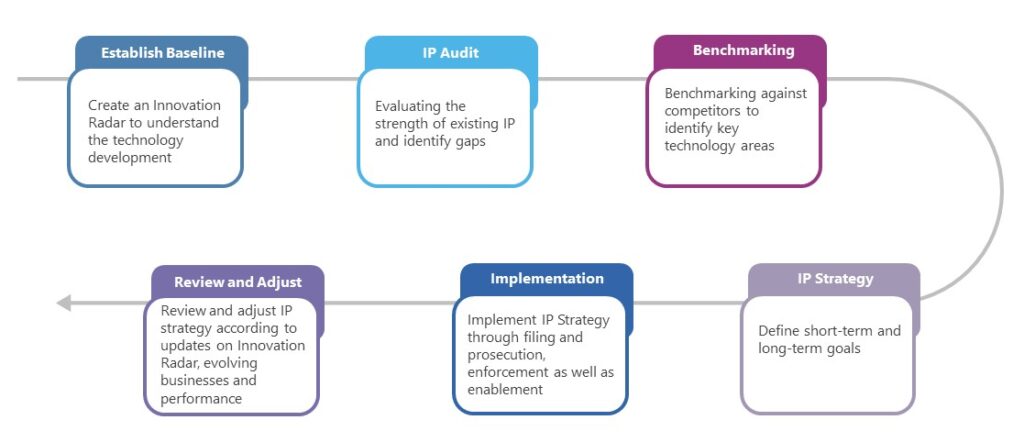Intellectual property (IP) is the guardian of unleashing innovation in the relentless march of technological advancement. Consider this: in 2023 alone, global patent filings surged by 5%, with tech giants like Apple and Tesla leading the charge. For businesses navigating this dynamic landscape, a robust IP strategy is not just a shield against infringement; it's a strategic weapon for market dominance. How can companies leverage the full potential of their intellectual assets? Let's dive into the steps to crafting a future-proof IP strategy that propels innovation and safeguards competitive advantage.

Crafting a Winning IP Strategy: Expert Insights
- Establish Baseline
Understanding the nuances of your client’s industry, innovations, and market dynamics is the cornerstone of an effective IP strategy.
- Innovation Intelligence: Conduct a comprehensive innovation intelligence focusing on technology trends, market movements, and regulatory changes. The Evalueserve IP and R&D Innovation Radar presents a view of technology growth in the near, mid, and long term that can influence the client’s strategic direction.
- Stakeholder Mapping: Identify critical stakeholders such as competitors, customers, suppliers, and regulatory bodies. This holistic view helps assess the broader impact of technological advancements on the client’s business ecosystem.
Real-World Example: When Dyson, renowned for its vacuum cleaners, ventured into the electric vehicle market, they extensively studied the technology segment and competitors to identify and protect their unique innovations, ensuring a solid footing in a new industry.
- Perform an IP Audit
With a clear understanding of the market landscape, the next step is to perform a thorough IP audit.
- Cataloging IP Assets: Create a detailed inventory of patents, trademarks, copyrights, trade secrets, and other IP assets. Evaluate each asset for its status and relevance.
- Assessing IP Strength: Evaluate the robustness of existing IP protections and identify areas for improvement. Ensure patents cover all critical markets and technologies pertinent to the client’s operations.
Real-World Example: IBM regularly conducts IP audits to leverage its vast portfolio of patents fully, identify opportunities to license technologies, and generate additional revenue streams.
- Benchmark Against Competitors
Staying ahead means knowing what the competition is doing. After the audit, the next step is competitor benchmarking.
- Competitor Analysis: Analyze competitors’ IP portfolios to identify their strengths and weaknesses. Look at recent patent filings, product launches, and strategic alliances.
- Technology Scouting: Identify key technologies competitors invest in and understand their potential impact on the client’s business. This step helps in setting priorities for future IP filings and R&D investments.
Real-World Example: A strategic competitor analysis identified smart home technology as a critical area for growth and innovation, driving Google’s acquisition of Nest Labs.
- Create IP Strategy
With a solid benchmark, it’s time to create an IP strategy by setting clear, actionable goals.
- Strategic Alignment: Integrate the IP strategy with the client’s business strategy. This approach involves aligning IP considerations with product development, marketing, and R&D planning.
- Short-term and Long-term Goals: Define immediate actions (e.g., filing patents, securing trademarks) and long-term strategies (e.g., developing a comprehensive patent portfolio in emerging technology areas). Prioritize technologies that align with the client’s vision and market demand.
Real-World Example: Tesla’s strategic filing of patents around battery technology and autonomous driving protects its innovations and aligns with its sustainable energy and transport vision.
- Implement the IP Strategy
Once you set the goals, begin the implementation phase.
- Filing and Prosecution: Manage the process of filing patents, trademarks, and other IP rights. Work closely with IP attorneys to ensure timely and accurate filings.
- IP Monitoring and Enforcement: Monitor the market for potential IP infringements and take necessary enforcement actions. Stay updated with changes to IP laws and regulations that could impact the client’s strategy.
- Innovation Enablement: Facilitate innovation by fostering partnerships, making informed manufacturing decisions, and adapting to market changes. Evalueserve’s approach includes partner scouting and benchmarking to select the right partners and technologies for the client. For in-house development, Evalueserve helps set IP processes for idea evaluation and harvesting.
Real-World Example: Microsoft’s proactive IP monitoring and enforcement strategy includes a dedicated team that tracks potential infringements, ensuring their software innovations remain protected and profitable.
- Regular Review and Adjustment
An effective IP strategy is dynamic and evolves with business and market changes. The final step is to establish a process for regular review and adjustment.
- Updating Innovation Radar: Closely watch new technology developments, market movements, and regulatory updates.
- Business Evolution: Adapt the IP strategy as the client’s business grows and diversifies, such as entering new markets or launching new products.
- Performance Metrics: Use key performance indicators (KPIs) to measure the effectiveness of the IP strategy and make data-driven adjustments as needed.
Real-World Example: Samsung’s IP strategy is regularly reviewed and adjusted to align with its rapid pace of innovation in electronics, ensuring continued market leadership.
Conclusion
A well-crafted IP strategy is essential for protecting and leveraging intellectual assets.
Understand the market, audit existing IP, benchmark against competitors, set clear goals, implement effectively, and regularly review and adjust to safeguard innovations and strengthen market positions. As your trusted advisor, I am committed to helping you navigate this complex landscape and achieve sustainable growth.
Talk to One of Our Experts
Are you ready to fortify your business’s innovation through a robust IP strategy? Let’s collaborate to protect your intellectual assets and drive sustainable growth.


